My friend Alastair Townsend sent me a link to a great Economist article about rice farming in contemporary Japan: highlighting its spiritual dimensions and the challenges of rural abandonment.
rice
Mochi making parties
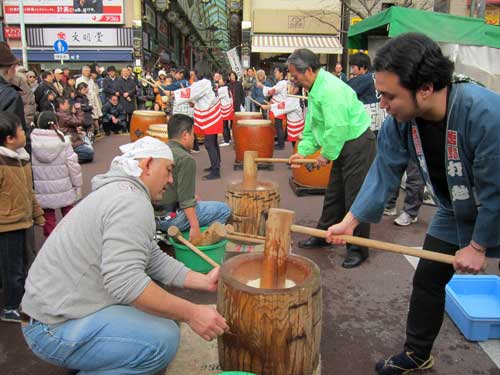
Mochi making parties are a winter community event. Above, a huge mochi party took place on Seijin no Hi (Coming of Age Day) on January 11 outside Nakano’s JR station. The event took place on the asphalt connecting the station with Sun Mall and normally occupied by smokers, taxis, buses, and pedestrians.
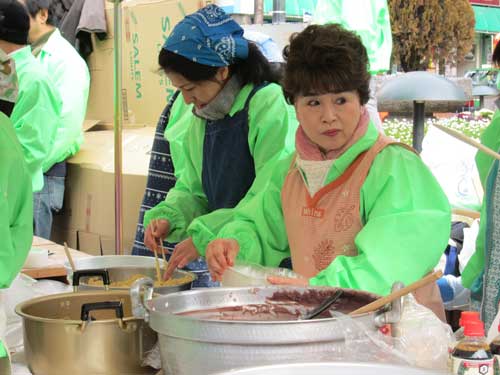
There were young girls playing taiko drums, men pounding rice, and women forming the rice into mochi balls. Did you know that a modern Japanese tradition for mochi eating is to keep a vaccuum cleaner nearby, in case the mochi gets stuck in elderly people’s throats?
Just before New Year, the ceramic studio where I practice pottery hosted a mochi making party for students, friends and relatives. Nearly thirty people attended, with many pounding the 18 kilos (40 lbs) of Niigata rice in the backyard, forming the sticky rice into balls, adding toppings, and sitting down to a huge feast. In fact, so much mochi was made that all the guests took some home for later.
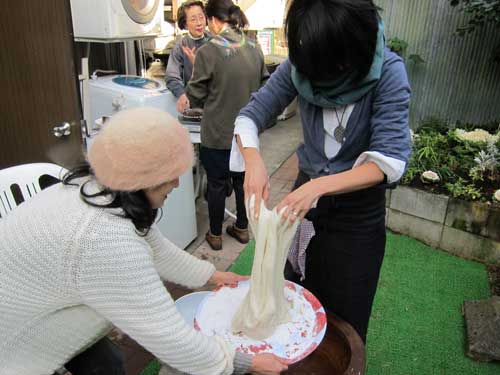
Some more photos after the jump of what the finished mochi looks like with many different toppings, the huge lunch feast, and the beautiful hand-written menu.
Creative Cities contributor

Over the next two months, I will be regularly contributing blog posts to Creative Cities, a project by the British Council focused on creative cities in the UK, East Asia, and Australia. Under the direction of Australian arts director and editor Jess Scully, the Creative Cities brings together some exciting ideas from thirteen countries about the role of creative cities in our changing world.
This month, the focus is on sustainable cities, and I am looking forward to the discussion generated by the contributors and readers. My first post describes the very Japanese mix of otaku (geek) culture, old traditions, and environmental activism as Akihabara maids plant and harvest rice. I am excited to be in this exciting East Asian and UK discussion of the role of creative cities in solving problems and making our lives better.
Gardening for Strangers in Tokyo: New Huffington Post article

The Huffington Post published the English version of my recent Newsweek Japan article. Entitled “Gardening for Strangers in Tokyo,” it argues that the smallest gardens connect city people with nature, culture and history. Written in a personal voice to show a foreigner’s view to a largely Japanese audience, the article emphasizes how “Tokyo’s distinctive streetscape encourages proximity with many small gardens and their gardeners,” creating human as well as environmental benefit.
Gardening for Strangers in Tokyo
(This article originally appeared in Newsweek Japan on January 12, 2009 in Japanese)
Spending several weeks in Tokyo on a business trip in 2008, I was startled and enchanted to discover its human scale and its streets alive with people and plants. Like many foreigners, I assumed Tokyo would be all cold high-rises, crowded Shibuya scrambles, and flashing neon advertising. In short, I imagined the world’s largest metropolis entirely removed from the natural world.
I brought to Tokyo a lifelong interest in gardening. What surprises me still are Tokyo residents’ ingenuity and passion for cultivating plants and community in a crowded, over-built city. On leaving a beginner’s ceramics class in a humble Tokyo neighborhood one day, I came across four perfect pansies growing in the crack of a narrow sidewalk.

This image of Tokyo as a gardeners’ city motivated me to relocate from San Francisco to research and write about Tokyo Green Space. Placing my research in the context of design anthropology and urban ecology, I was extremely fortunate to receive generous support in 2009 from Hitachi, which is committed to a Japanese approach to environmental protection and to cultural diplomacy.
The sidewalk pansies show that Tokyo is organized differently than United States and European cities, and that many of these differences are nearly invisible to Japanese people. I formulated several guiding questions. Why do Tokyo residents care so deeply about their surroundings? What role can nature play in dense urban environments? What can other cities learn from Tokyo’s urban gardening culture?
I began collecting images of gardens visible from streets and sidewalks. Surprises included a valuable bonsai collection growing on a private residence’s cinder block wall; rice maturing in styrofoam containers; a single, exquisite mini-watermelon supported by a wooden stand in a Ginza backstreet. Sadly, in San Francisco and most developed world cities, these potted plants would be quickly stolen or vandalized. Meanwhile few Tokyo residents connect the respect shown to public plants with their unequaled personal safety in streets and transit.

Rushing into a men’s room in the Tokyo Metro, I glimpsed ivy growing in a two-liter plastic bottle lying on its side. In the twenty-first century, United States cities permanently closed their subway restrooms for “public safety.” Here in Tokyo I could calmly imagine the anonymous person who beautified an underground utility with a living organism and minimal resources. Did he return regularly to change the water? What inspired his passion for plants and his kindness to strangers?

Across the four seasons, I observed Tokyo residents celebrating nature together in public places. For hanami (cherry blossom viewing), it is common to see people sleeping overnight in parks and along rivers to reserve spaces for blue sheets and the next day’s outdoor party for family, co-workers, or friends. The pink cherry blossoms transform the entire city as boisterous crowds share drinks and food. In fall, many thousands view ginko trees turning bright yellow in Aoyama, and special evening “light up” displays of red maple trees in traditional Japanese public gardens.
City people connecting with the people growing their food

The last post about Big Globe reminded me of two recent dinners I attended in Tokyo and Kanagawa which featured food with visible and interactive connections to the farmers who produced them.
The first was a mochi party at the ceramic studio where I am a student. Their annual mochi party used special rice grown by Niigata farmers. The teachers found them online last year, and this year along with the huge bag of rice, they included the above image showing the family that creates the rice. I like how they also include a QR code.

The other event was a lavish dinner hosted by a Japanese architect friend that featured Kyushu pork fed a persimmon diet. The dinner included seven courses all of which included pork and persimmon, including an amazing sweet-and-sour and a tonkatsu with cream cheese and persimmon inside the batter. Both at the party and in the email invitation, we learned about the River Wild Ham store, and how it used fallen organic persimmons from Kakinoya farm as feed. The taste was astounding.
Given the discussion of technology in the previous post, it is interesting how these rural farmers are connecting with city people with online stores, blogs, QR codes, and Flickr accounts. I do not fully understand the “21st century rock and roll heart” branding, but clearly the pork store wants to be contemporary and relevant to today’s buyers.
Lastly, I realize that more and more vegetables in Tokyo now include images of the farmer. Well, given how industrial most farming is, I wonder how accurate some of these images are. Still, I think it is part of a broader interest by city people to know where their food comes from, how it is made, and who is making it.

Happy new year 2010
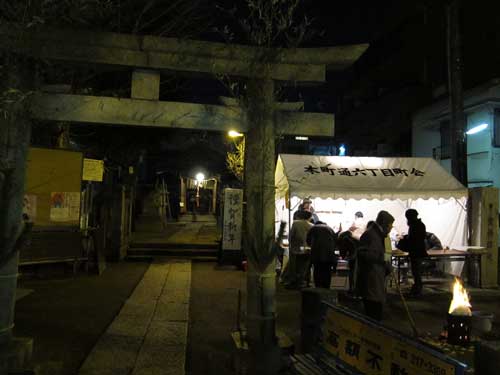
あけましておめでとうございます! 2010 began on a cold night in Tokyo one hour ago. We visited our local shrine: no line, hot rice drink, and a tiny bonfire. The small shrine’s doors were open, revealing that our local gods live amidst folding chairs and assorted bric-a-brac.
The visit to the shrine followed many hours of Kouhaku, the annual music extravaganza on NHK, plus a Johnny’s shmorgasbord of dozens of boy bands, dizzying video displays, and stages gliding over crazed fangirls. A very traditional new year in Japan.
Below is the “blue” moon, the second full moon of the month. Best wishes for the new decade!
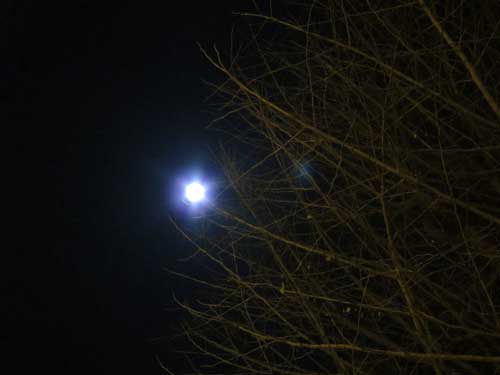
New year decorations
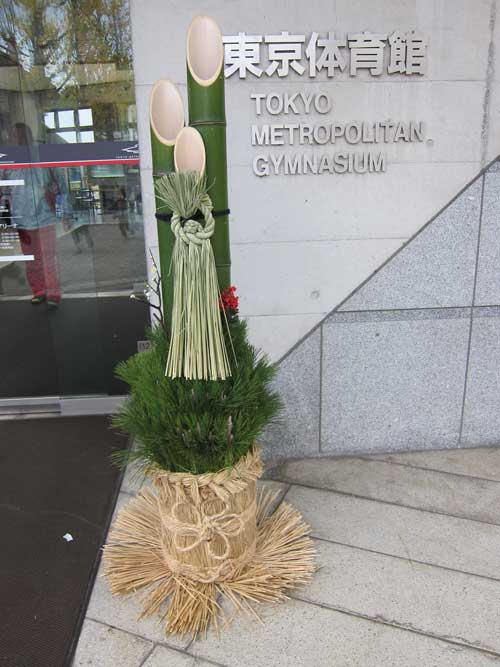
Above is a kadomatsu, or new year’s decoration that rests on the ground. These large ones are usually in front of businesses. This one is in front of one of my favorite Tokyo haunts: the Tokyo Metropolitan Gymnasium constructed for the 1964 Tokyo Olympics and open to the public now in central Tokyo.
The materials are bamboo, pine, straw and red berries. I love the decorative rope flower and the splayed straw at the base. Below is the shimekazari hanging outside of our apartment door. Notice the folded paper and rice stalk. After the holiday, these plant-based new year’s symbols are burned at shrines. So different than the un-ceremonial sidewalk dumping of US Christmas trees.
Happy new year! Best wishes for a bright new decade.
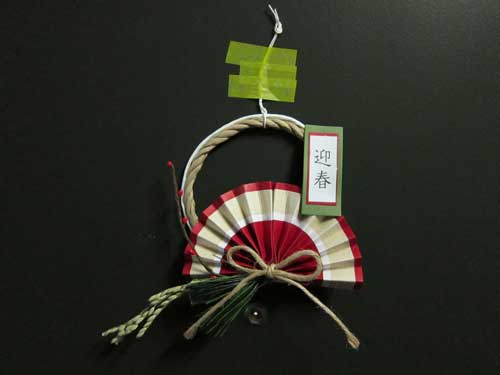
Shimekazari at Muji
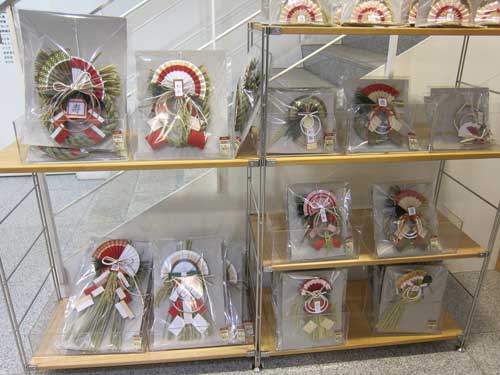
On my way to price a vaccuum cleaner for our tatami floors (ended up buying at 1300 yen used vaccuum at a recycle shop), I was surprised to see this display of shimekazari at Muji, which was busy blasting Xmas music and offering holiday specials.
Shimekazari are end of the year Shinto displays for the home. They can include rice, rope, pine, and folded paper, and welcome ancestral harvest kami or spirits. Smaller ones hang on the door, and larger ones sit outside of homes and shops.
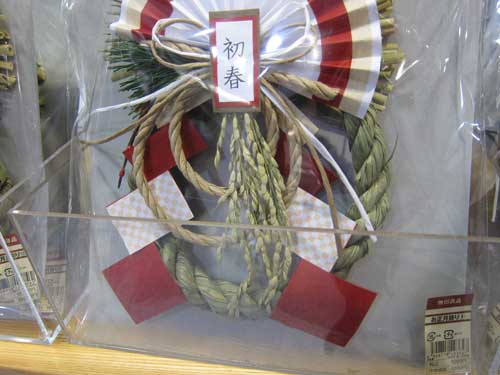
Seeing shimekazari inside Muji was an uncanny juxtaposition of Shinto shrine and modern commerce, old Japan and Xmas, agrarian and urban.
City and Country, 1970s and now

“The Japanese think of the City in the way that Englishmen used to think of Mighty London. It is either one or the other. Rice paddies or the Ginza.” (p35)
I am reading the wonderful author Donald Richie’s The Inland Sea, first published in 1971. Richie is the ultimate American expat in Japan, who stayed from the start of the Occupation until today, and this is a classic travel book focused on Seto Nai Kai (the Inland Sea), which I recently visited.
This passage struck me because Ginza Farm, which I have visited for Tokyo Green Space, overcomes the division between city and country by bringing a rice paddy to Ginza, Tokyo’s most celebrated commercial district full of De Beers, Cartier and now of course Uniqlo flagship stores.
Richie’s The Inland Sea also reminds me of the recently deceased French anthropologist Claude Levi-Strauss’ Tristes Tropiques, which chronicled an Amazon on the verge of extinction. In a similar voyage by boat, Richie bemoans the new highways and lure of the city that threaten the fishing economy and general isolation of these islands and peoples. What used to be called “salvage anthropology” clashes with contemporary feelings by focusing on purity and what is about to be lost. This antique attitude also portrays the writer as both the “first” and last foreigner to capture a vanishing culture, creating a false sense of importance for the individual writer.
Despite this unease, it is hard not to enjoy Richie’s beautiful writing, his insights on insider and outsider culture, and his only partly closeted attraction to Japan. And I do not doubt the gulf that once existed between city and country, which makes the current urban interest in rural life and agriculture all the more indicative of profound social and environmental change.
On a related topic, I read this week in the New York Times that Korea, which is generally more accepting of national diversity, is having difficulties integrating children of mixed marriages. Most mixed children are the progeny of Korean farmers and their Chinese, Filipino and Thai wives. Partly the social question is of race, but also of class and city versus country.
I was struck that Korea shares Japan’s rural abandonment, and seems ahead of Japan in responding through immigration. Perhaps Japan, too, will first open its doors to immigrants willing to live in its rural areas now inhabited almost exclusively by the elderly. Despite Japan’s xenophobia, immigrants as care-givers and farmers seem more likely than the techno fantasy of robots: more cost-effective as workers and more human in terms of care and culture.
Japan Times: Tokyo’s urban design role

The Japan Times published my op-ed article “Tokyo’s urban design role.” My argument is that Tokyo’s past urban design failures paradoxically make it a model for rebuilding existing cities and designing hundreds of emerging cities. In the context of climate change and global warming, livable cities can create a new balance between people and nature.
I talk about fireflies, Ginza rice and honeybees, modern bonsai, satoyama in the city, businesses and biodiversity, and how Japan can promote innovations in urban life, alongside achievements in popular culture and high technology.
Shin Edogawa in fall
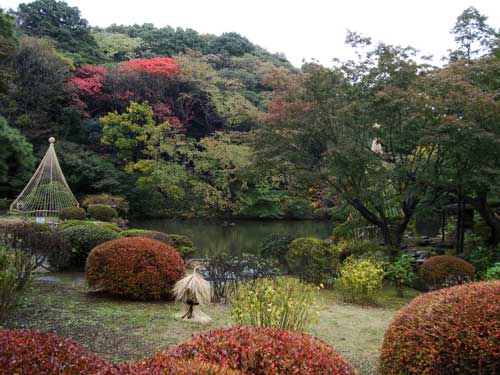
With a few minutes to spare before meeting Hiraga Tatsuya of Landscape+, I stepped into nearby Shin Edogawa park. The colors were beautiful, and empty apart from a couple having formal wedding photos taken in traditional costume. I wonder what the small seasonal sculpture is. There were several placed in the garden, and they seem to be made of rice stalks, and possibly with a religious meaning.
Please let me know if you know. Here’s a close-up.
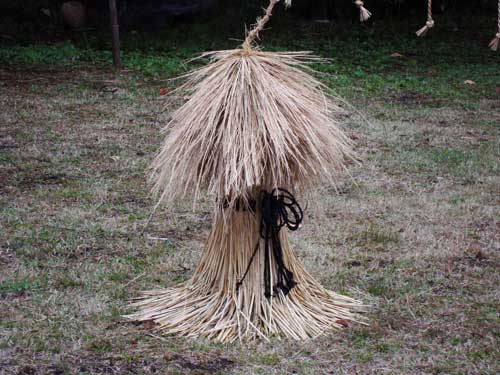
And another garden photo after the jump.
Inujima: Reclaiming the Past to Envision the Future
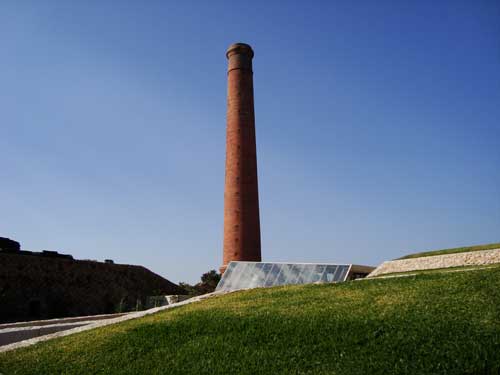
In spring the sustainability director of ARUP showed me the incredible designs for Inujima Art Project, and I had known immediately that I wanted to visit and see it for myself. In an earlier post, I discussed its zero energy use through a creative natural cooling, heating and lighting system, and its wastewater recycling program.
Also listed was the the architecture by Sambuichi Hiroshi, art by Yanagi Yukinori using elements from Mishima Yukio’s house and writings, and the benefactor Fukutake Soichiro, Benesse‘s owner and the creator of nearby Naoshima, another island in the Seto Inland Sea.
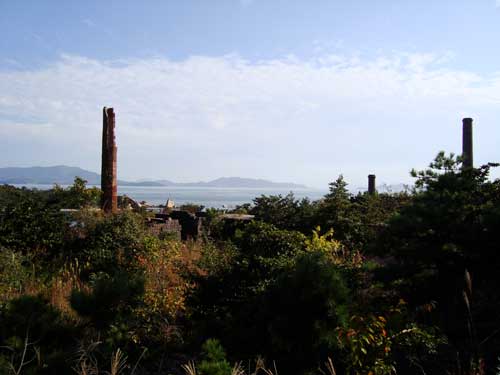
Visiting Inujima on a beautiful fall day in October and spending the night in a school house closed many years ago and converted into a hostel was an incredible experience combining nature, recent history, art, and questions about Japan’s industrial past and its 21st century future.
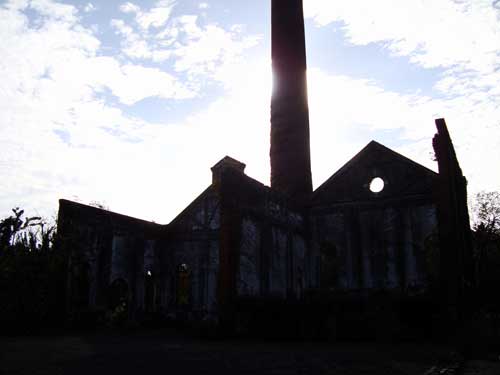
Inujima in the early 20th century was a small island with over 3,000 inhabitants in the early 20th century. In a brief period of ten years, Inujima was the site of a massive seirenshou, or copper refinery, placed in the Seto Inland Sea to keep the intense pollution away from Japan’s population centers. With the collapse of copper prices after only ten years, the refinery closed and the island entered a long period of decline.
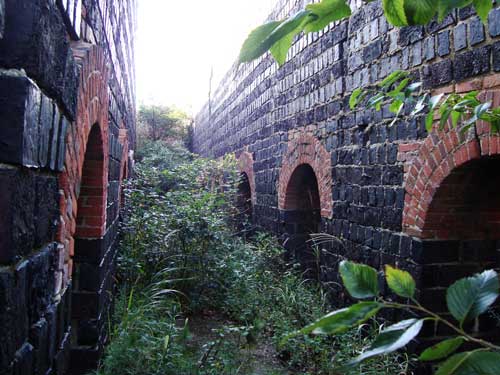
Today there are approximately 50 residents, with an average age of 70 or more. The chimney built just before the refinery closed now serves as an integral part of the zero emissions temperature system in the new museum structure. Earlier chimneys had less structural integrity, and large parts of the refinery, including its original power station, are now being reclaimed by thick forest.
After the jump, a discussion of the art work and the island today.
Ginza Farm rice harvest
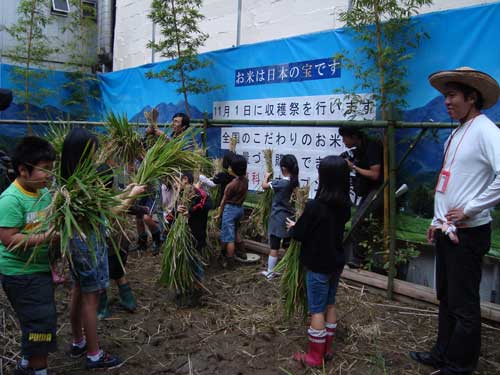
On November 1, Ginza Farm celebrated the rice harvest. The event began at 9 am on a Sunday morning and drew a crowd including children, parents, bloggers, an actress in an upcoming movie about farming, and the carpenter Hisano who built the beautiful tanbo, tables and benches. Above entrepreneur Iimura san helps the kids hang the rice along a bamboo rail.
Here’s what the rice looked like just before harvest.
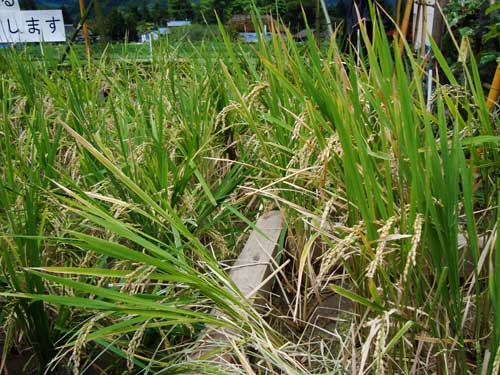
Below is a photo of Hisano san, the Chiba carpenter who created Ginza Farm and Omotesando Farm.
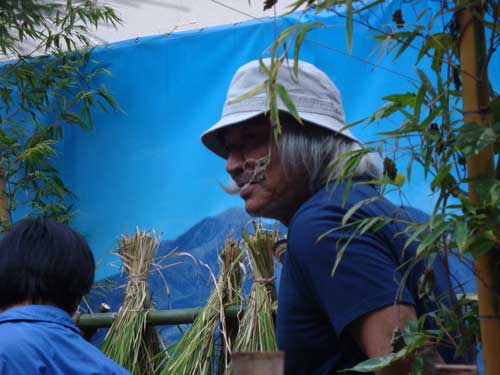
After the jump are photos of the actress helping the children bundle the rice, two kids enjoying the remaining duck, and a sad note about how one duck died the previous week from an assault by a Ginza raccoon.
Residential rice harvest
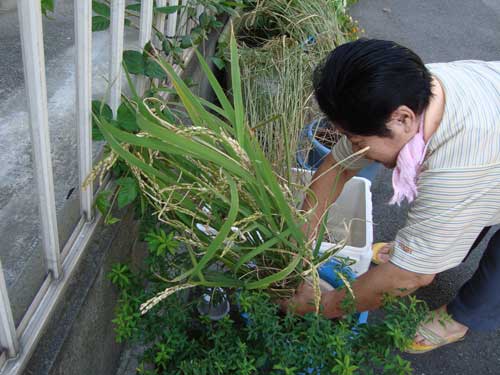
One of my neighbors tends an interesting garden on the edge of a small street leading to the JR station. I previously blogged about her spring peonies and her use of recycled containers for growing rice. On October 13, I stopped in front of the rice plants and was surprised how dry the soil was. Within minutes, my neighbor came out and told me that she was going to harvest the rice. It did not take long.
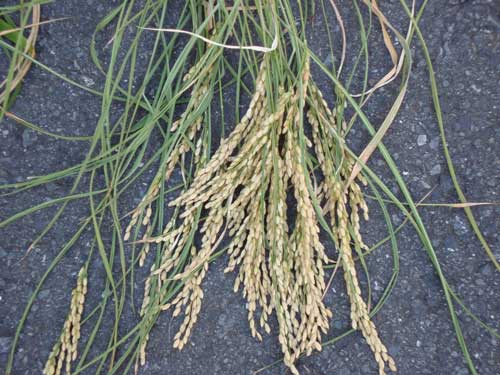
Next time I see her, I have to ask her how it tasted.
Maids’ environmental group in Akihabara
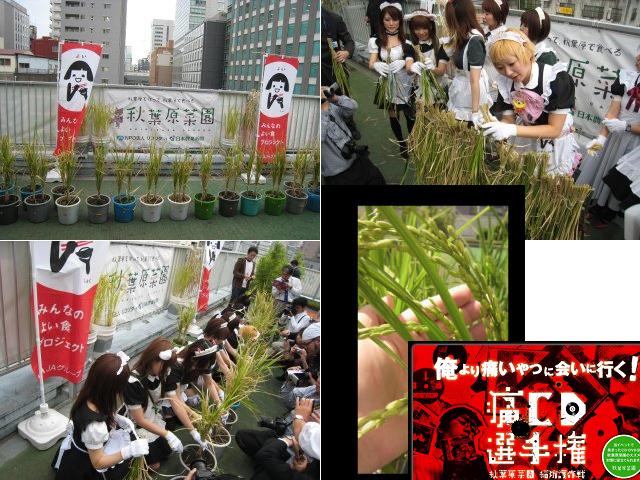
Thanks to a great Japan eco-blog Kurashi, I learned about an Akihabara maids organization called Licolita that is involved in public environmental activities: including summer-time uchimizukko (splashing water on the sidewalk to lower ambient temperature), blessing bicycles at a shrine, and now growing and harvesting rice in rooftop pots. It is cool that this group is so focused on otakus (manga and anime fans) and raising their awareness and interest in urban ecology and agriculture.